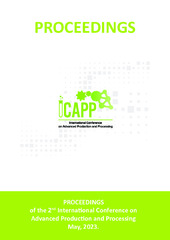Prikaz osnovnih podataka o dokumentu
Probiotic almond-based beverage: promising step towards a circular bioeconomy
| dc.creator | Rakin, Marica | |
| dc.creator | Bulatović, Maja | |
| dc.creator | Živanović, Sara | |
| dc.creator | Milutinović, Milica | |
| dc.creator | Rakin, Duška | |
| dc.creator | Zarić, Danica | |
| dc.creator | Vukašinović-Sekulić, Maja | |
| dc.date.accessioned | 2023-12-21T14:25:38Z | |
| dc.date.available | 2023-12-21T14:25:38Z | |
| dc.date.issued | 2023 | |
| dc.identifier.isbn | 978-86-6253-167-4 | |
| dc.identifier.uri | http://TechnoRep.tmf.bg.ac.rs/handle/123456789/7013 | |
| dc.description.abstract | The search for waste minimization possibilities and the valorization of by-products are key to good management and improved sustainability in the food industry. Although dairy products still remain at the forefront of probiotic food development, in recent years non-dairy food products have increased in popularity owing to their unique characteristics and advantages. Due to its beneficial properties, caused by the presence of various bioactive compounds, the almond parts that remain after almond milk production can be considered promising sources of ingredients for the development of non-dairy food products. The aim of this study was to examine the potential and possibility of using a surplus product that remains after almond milk production. The antioxidant properties of the remained surplus product were characterized based on the polyphenol, flavonoid, and anthocyanin content as well as FRAP, DPPH, and ABTS antioxidant activity. The fermented beverage that combines the properties of almonds and probiotic bacteria, formulated using inulin, lyophilized fruit and aroma, was evaluated for physicochemical, microbiological, and sensory properties during cold storage (4 °C, 21 day). The surplus product that remains after the almond milk production contains 61.4 mg GAE/100g DW, 16.11 mg QE/100g DW, and 0.993 mg CYE/100g DW of polyphenols, flavonoids, and anthocyanins (respectively), and expresses DPPH, FRAP and ABTS antioxidant activity of 71.56 mg DW/mL, 50.47 mg DW/mL and 53.11 mg DW/mL (respectively). The fermentation of surplus product that remains after almond milk production leads to the production of the beverage with satisfactory values of quality parameters as follows: pH value of 4,75, titratable acidity 28,8 °SH, syneresis 7,5%, viable cell count of 7.77 log (CFU mL-1), and sensory characteristics value of 10, that is stable during 21 day of cold storage. A new probiotic almond-based beverage that combines the properties of both almonds and probiotics can be considered as promising step toward the circular bioeconomy. | sr |
| dc.language.iso | en | sr |
| dc.publisher | Novi Sad : Faculty of Technology | sr |
| dc.relation | info:eu-repo/grantAgreement/MESTD/inst-2020/200287/RS// | sr |
| dc.rights | openAccess | sr |
| dc.rights.uri | https://creativecommons.org/licenses/by/4.0/ | |
| dc.source | Proceedings of the 2nd International Conference on Advanced Production and Processing ICAPP 2022, Novi Sad | sr |
| dc.subject | Almond | sr |
| dc.subject | beverage | sr |
| dc.subject | probiotics | sr |
| dc.subject | circular bioeconomy | sr |
| dc.subject | antioxidants | sr |
| dc.title | Probiotic almond-based beverage: promising step towards a circular bioeconomy | sr |
| dc.type | conferenceObject | sr |
| dc.rights.license | BY | sr |
| dc.citation.epage | 64 | |
| dc.citation.spage | 54 | |
| dc.identifier.fulltext | http://TechnoRep.tmf.bg.ac.rs/bitstream/id/19228/Probiotic_almond_based_pub_2023.pdf | |
| dc.identifier.rcub | https://hdl.handle.net/21.15107/rcub_technorep_7013 | |
| dc.type.version | publishedVersion | sr |

